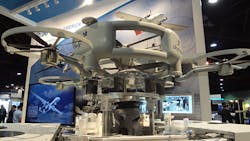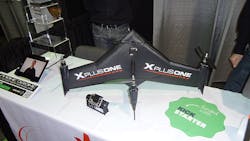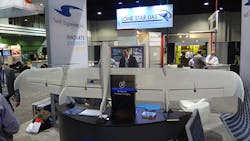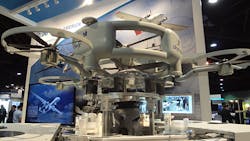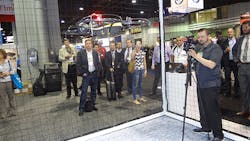VTOLs and Tethered Drones Take to the Sky at AUVSI 2015
To say there were a few dozen quadrotor UAVs at this year’s AUVSI show would be an understatement. They came in all shapes and sizes. What caught my eye, though, were a couple of VTOL UAVs—like xCraft’s X PlusOne flying wing (Fig. 1).
Also be sure to check out Bill and Curtis’ image gallery, “AUVSI 2015 First Looks.”
The X PlusOne can fly horizontally at 60 miles/hour. It is also more efficient than a conventional, hovering quadcopter, even though it has four propellers and engines. The drone weighs in at 2.8 pounds. It has a flight time of 15 minutes, which is similar to other platforms in its class. It can mount a range of payloads including a 2-axis GoPro gimbal mount. It costs about $499.
The larger VTOL is Swift Engineering’s X Blade (Fig. 2). This three-bladed aircraft is also electrically powered, but it has a wireless charging unit. Swift Engineering also has its own power system that can work with a solar panel to charge a secondary battery that will in turn be used to charge the VTOL when it has landed. The flight time and range is significantly better than the X PlusOne, given its larger size and battery capacity.
Another interesting platform is from Israel Aerospace Industries. The Sky Sapience platform, also known as HoverLite for the U.S. market, is a tethered platform (Fig. 3). It is contained in its own launch platform that can automatically eject and fly the drone to heights up to 165 feet within two minutes. It can hold the electric drone steady for long durations because the power is provided by a generator on the ground. Power and control are brought up the cable. The base can move as it is typically mounted in the back of a truck or on a boat.
The typical payload is similar to other UAVs, such as high-resolution, gimbaled camera platforms. The system can be used almost anywhere because it is not a free-roaming system.
The automated system is very easy to use. The cover to the box containing the drone opens at the touch of a button. The control rotors pivot out automatically. The center rotor provides the primary lift. The control panel on the ground has an indicator that changes color based on crosswinds. Green means everything is fine while yellow indicates the system is being stressed. It automatically lands the unit if it redlines.
SenseFly’s eXom is designed for professional commercial use on tasks such as checking on the integrity of bridges (Fig. 4). It is a quadcopter with camera/ultrasonic sensor combos placed around its periphery. This provides detailed range information as well as better visual context awareness.
What sets the eXom apart is its mapping and autonomous operation. Users can map out areas to be photographed and the system determines the waypoints and camera angles to get the job done. The final analysis is done on the ground on a PC application using this data.
SenseFly is a Parrot company. Parrot also makes the Bebop Drone (see “Bebopping Around”). SenseFly also has a fixed wing drone that can handle mapping chores as well. It is called the eBee.
I will be here two more days for the show, so there is more to come. It has been a long, but interesting day. I’ll have more drone news and photos in the near future as well as videos on Engineering TV.
About the Author
William Wong Blog
Senior Content Director
Bill's latest articles are listed on this author page, William G. Wong.
Bill Wong covers Digital, Embedded, Systems and Software topics at Electronic Design. He writes a number of columns, including Lab Bench and alt.embedded, plus Bill's Workbench hands-on column. Bill is a Georgia Tech alumni with a B.S in Electrical Engineering and a master's degree in computer science for Rutgers, The State University of New Jersey.
He has written a dozen books and was the first Director of PC Labs at PC Magazine. He has worked in the computer and publication industry for almost 40 years and has been with Electronic Design since 2000. He helps run the Mercer Science and Engineering Fair in Mercer County, NJ.
- Check out more articles by Bill Wong on Electronic Design
- Bill Wong on Facebook
- @AltEmbedded on Twitter
